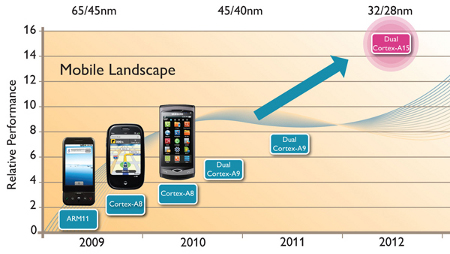ARM makes its attack on the server market official
Dec 14, 2010 — by LinuxDevices Staff — from the LinuxDevices Archive — 3 viewsARM Holdings has officially acknowledged its plans to take on Intel in the server market. However, CEO Warren East is quoted as adding that ARM licensees won't begin to erode Intel's market share until 2014.
As Intel pushes to expand its technology into the rapidly growing mobile device space, officials with ARM Holdings — whose chip designs dominate the smartphone market — are countering by saying they plan to take on Intel in the server arena.
 In an interview with Bloomberg News Dec. 13, ARM CEO Warren East (right) said that his company's chip designs will help drive up the energy efficiency of data center systems, and that server makers "are actively considering ARM architectures.'
In an interview with Bloomberg News Dec. 13, ARM CEO Warren East (right) said that his company's chip designs will help drive up the energy efficiency of data center systems, and that server makers "are actively considering ARM architectures.'
However, that will take time, East said, predicting that ARM won't start to eat into Intel's dominant server market share until 2014 or so. Intel currently owns more than 90 percent of the overall server market.
"We don't want to raise expectations that next year there are going to be a lot of ARM servers," he said. "Of course, there aren't."
But ARM, and some chip designers using designs licensed from the company, have begun the work to move in that direction. ARM officials in September introduced the Cortex-A15, their next major chip design that, they say, will offer features that are important for server designers — including support for virtualization and greater memory capacity.

ARM's Cortex-A roadmap shows a 2012 debut for Cortex-A15 SoCs
(Click to enlarge)
According to ARM, the Cortex-A15 will include a five-fold increase in performance in a power envelope similar to current ARM designs. Chips using the design will be able to run at up to 2.5GHz and with as many as 16 cores, the company adds.
"It's a pretty big bump in performance," Nandan Nayampally, director of product marketing for ARM, said at the time of the announcement. "It opens up our markets to very new [products]."
A number of chip makers — including Texas Instruments, Qualcomm and Samsung — use ARM designs in manufacturing their processors. However, there are already several companies looking to take advantage of ARM designs to create low-power servers for such environments as cloud computing.

Marvell's Armada XP
Marvell officials in November started demonstrating their quad-core Armada XP chip (above), based on ARM designs. The chip runs at 1.6GHz and includes features that can be used in servers, including four enterprise-class networking ports, up to 2MB of Level 2 cache, 4 PCI Express Gen 2.0 units and multiple USB ports.
Another company, Calxeda, also is working on server chips based on ARM's Cortex-A9 design, with plans to release samples next year and start manufacturing the processors in 2012.
ARM's East said the key for his company is the ability now to free up their chip designs from the battery constraints found in mobile devices. Without those constraints, the ARM-based chips can run faster. They're also more energy-efficient than Intel processors, he said.
"We could certainly halve the power of these things," East said, noting that with data centers packing more servers, "the challenge is delivering the energy and taking the heat away."
Trouble for Microsoft?
Incursions by ARM into the server space could be a blow to Microsoft, which currently offers no server operating system for ARM CPUs. ZT Systems recently announced a Ubuntu Linux-based 1U rackmount server with SSD (solid state disk) storage and eight ARM Cortex-A9 COMs (computer on modules) on board. The R1801e (below) provides 16 600MHz cores while using less than 80 Watts, according to the company.

ZT Systems' R1801e
(Click to enlarge)
ARM servers could offer a promising new market for Canonical and its Ubuntu Server OS. Back in 2008, Canonical and the Ubuntu community made the wise move of porting Ubuntu to ARM.
Meanwhile, both Intel and x86 rival Advanced Micro Devices are eyeing the mobile device space as a way to expand their businesses beyond PCs and servers. At an event earlier this month, Intel President and CEO Paul Otellini said that he expects smartphones powered by his company's upcoming 32nm "Medfield" Atom processor will start hitting the market in the second half of 2011.
Otellini also said that PC makers — including Dell, Asus, Lenovo and Toshiba–have said they plan to use Atom chips in 35 different tablet PC designs. Intel has two Atom platforms for tablet PCs — "Oak Trail" for tablets running Windows, and "Moorestown" for those running Android or MeeGo.
Jeffrey Burt is a writer for our sister site eWEEK.com.
This article was originally published on LinuxDevices.com and has been donated to the open source community by QuinStreet Inc. Please visit LinuxToday.com for up-to-date news and articles about Linux and open source.